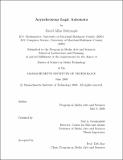Asynchronous logic automata
Author(s)
Dalrymple, David Allen
DownloadFull printable version (1.986Mb)
Other Contributors
Massachusetts Institute of Technology. Dept. of Architecture. Program in Media Arts and Sciences.
Advisor
Neil A. Gershenfeld.
Terms of use
Metadata
Show full item recordAbstract
Numerous applications, from high-performance scientific computing to large, high-resolution multi-touch interfaces to strong artificial intelligence, push the practical physical limits of modern computers. Typical computers attempt to hide the physics as much as possible, running software composed of a series of instructions drawn from an arbitrary set to be executed upon data that can be accessed uniformly. However, we submit that by exposing, rather than hiding, the density and velocity of information and the spatially concurrent, asynchronous nature of logic, scaling down in size and up in complexity becomes significantly easier. In particular, we introduce "asynchronous logic automata", which are a specialization of both asynchronous cellular automata and Petri nets, and include Boolean logic primitives in each cell. We also show some example algorithms, means to create circuits, potential hardware implementations, and comparisons to similar models in past practice.
Description
Thesis (S.M.)--Massachusetts Institute of Technology, School of Architecture and Planning, Program in Media Arts and Sciences, 2008. This electronic version was submitted by the student author. The certified thesis is available in the Institute Archives and Special Collections. Includes bibliographical references (p. 89-92).
Date issued
2008Department
Program in Media Arts and Sciences (Massachusetts Institute of Technology)Publisher
Massachusetts Institute of Technology
Keywords
Architecture. Program in Media Arts and Sciences.